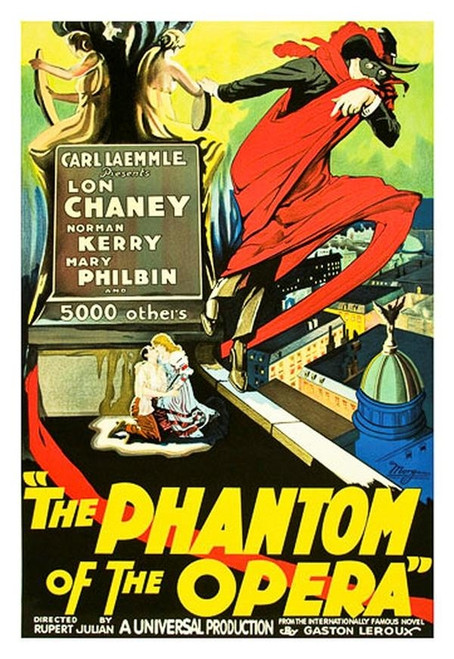Gaston Leroux, the author of the hit mystery-horror novel Le Fantome de l'Opera had met Carl Laemmle in 1922 when the studio head was in Paris on vacation. The interaction was not entirely random. After the initial failure of "Phantom," Leroux had begun writing for the budding film industry in France and had solidified himself as a writer of all mediums by the time this chance meeting had occurred. "In an otherwise desultory conversation the American film mogul mentioned to Leroux how impressed he had been by the vast Paris Opera House [...] Leroux responded by giving Laemmle a copy of his even-by-then disregarded book of 1911. The president of Universal Pictures read it through in a single night." (Forsyth. Phantom of Manhattan)
Production started in late 1924 and it did not smoothly. Set design of the backstage and cellars of the Paris Opera House proved so difficult for Universal, French artist Ben Caray had to be brought in having had worked in the French theater to replicate the floor plans. Chaney as well as the rest of the cast and crew found it difficult to work with director Rupert Julian. Tension hit a fever pitch when the director of photography, Charles Van Enger, became their go-between. Van Enger's reports back to Julian from Chaney would usually result in telling the director to go and "screw himself." "The Man of the Thousand Faces" would end up directing his own scenes.
"The Man of the Thousand Faces" also had freedom to create his own makeup after the success of the makeup done in "The Hunchback of Notre Dame." (1923) His creation would have been the most accurate of all of the film and stage adaptations, with Chaney's eye sockets and nostrils painted black as well as wire pinning the tip of his nose up. A set of jagged false teeth were also applied. Chaney's cosmetics proved so effective when in theaters, moviegoers were known to have screamed or fainted when the Phantom's mask was pulled off in the now iconic scene.
It would have taken three versions for the "Phantom" to become the emblematic horror film as we know it today. Maurice Pivar and Lois Weber ended up editing the initial 1924 film from the attempted romantic comedy made by Edward Sedgwick which was booed off the screen when previewed in April 1925. After shedding off most of the embarrassment, "The Phantom of the Opera" was officially released on September 6th, 1925 at the Astor Theater in New York City and in Hollywood the next month. A full organ was placed in the Astor just for the opening. The film was a success, grossing over $2 million at the box office. Mordaunt Hall of The New York Times comes across as mixed dubbing the film as "an ultra fantastic melodrama, an ambitious production in which there is much to marvel at in the scenic efforts. It has been produced with a sort of mechanical precision" yet considers that "the narrative could have been fashioned in a more subtle manner and would then have been more interesting to the few." TIME also was underwhelmed, calling the film a "brave attempt" and "seems only pretty good."
"The Phantom of the Opera" will be on TCM October 3rd, 9 PM EST/8 PM CST
Links to Check Out







No comments:
Post a Comment